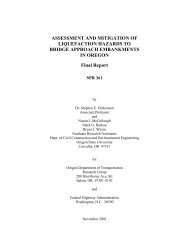Oregon Balance of State HIV/AIDS Housing & Services Systems ...
Oregon Balance of State HIV/AIDS Housing & Services Systems ...
Oregon Balance of State HIV/AIDS Housing & Services Systems ...
Create successful ePaper yourself
Turn your PDF publications into a flip-book with our unique Google optimized e-Paper software.
Executive Summary—<strong>Oregon</strong> <strong>HIV</strong>/<strong>AIDS</strong> <strong>Housing</strong> and <strong>Services</strong> <strong>Systems</strong> Integration Plan i<br />
Executive Summary<br />
This Executive Summary includes a statement <strong>of</strong> the purpose behind this systems integration plan,<br />
an overview <strong>of</strong> the needs assessment and planning process, key findings, and critical issues that<br />
were identified and recommendations that were developed by the Steering Committee.<br />
Many people living with <strong>HIV</strong>/<strong>AIDS</strong>, at some point during their illness, find themselves in need <strong>of</strong><br />
housing assistance and support services. Stable housing promotes improved health, sobriety or<br />
decreased use <strong>of</strong> alcohol and illegal drugs, and, for some, a return to paid employment and<br />
productive social activities. As the number <strong>of</strong> people living with <strong>HIV</strong>/<strong>AIDS</strong> continues to grow in<br />
both urban and rural areas throughout the United <strong>State</strong>s, stakeholders must find new ways to<br />
address their needs to promote the health and well-being <strong>of</strong> these individuals and their families.<br />
Increasingly, maximizing the resources available to people who need them requires partnering<br />
across mainstream housing and human services systems to ensure continuity <strong>of</strong> care, program<br />
efficiency, and that there is “no wrong door” to assistance for clients at risk.<br />
In order to improve the ability <strong>of</strong> the <strong>State</strong> <strong>of</strong> <strong>Oregon</strong> to establish and sustain such partnerships, the<br />
U.S. Department <strong>of</strong> <strong>Housing</strong> and Urban Development (HUD) funded the development <strong>of</strong> the <strong>Oregon</strong><br />
<strong>HIV</strong>/<strong>AIDS</strong> <strong>Housing</strong> and <strong>Services</strong> <strong>Systems</strong> Integration Plan in August 2007. The plan was facilitated<br />
by Building Changes (formerly <strong>AIDS</strong> <strong>Housing</strong> <strong>of</strong> Washington), a national <strong>HIV</strong>/<strong>AIDS</strong> housing<br />
technical assistance provider based in Seattle. Building Changes worked closely with the <strong>Oregon</strong><br />
Department <strong>of</strong> Human <strong>Services</strong>, the grantee for HUD’s <strong>Housing</strong> Opportunities for Persons with<br />
<strong>AIDS</strong> (HOPWA) program for <strong>Oregon</strong> <strong>State</strong> outside <strong>of</strong> the five-county Portland metropolitan area.<br />
This area is referred to as the <strong>Oregon</strong> “balance <strong>of</strong> state.”<br />
The <strong>Oregon</strong> <strong>Housing</strong> Opportunities in Partnership (OHOP) program has been administered by the<br />
<strong>Oregon</strong> Department <strong>of</strong> Human <strong>Services</strong>, Public Health, <strong>HIV</strong>/STD/TB Section, <strong>HIV</strong> Care and<br />
Treatment program (<strong>HIV</strong> Care and Treatment) since 2002. The four OHOP <strong>Housing</strong> Coordinators<br />
serve four regions <strong>of</strong> the balance <strong>of</strong> state.<br />
Figure 1 on the following page shows a map <strong>of</strong> the four OHOP service regions.

















